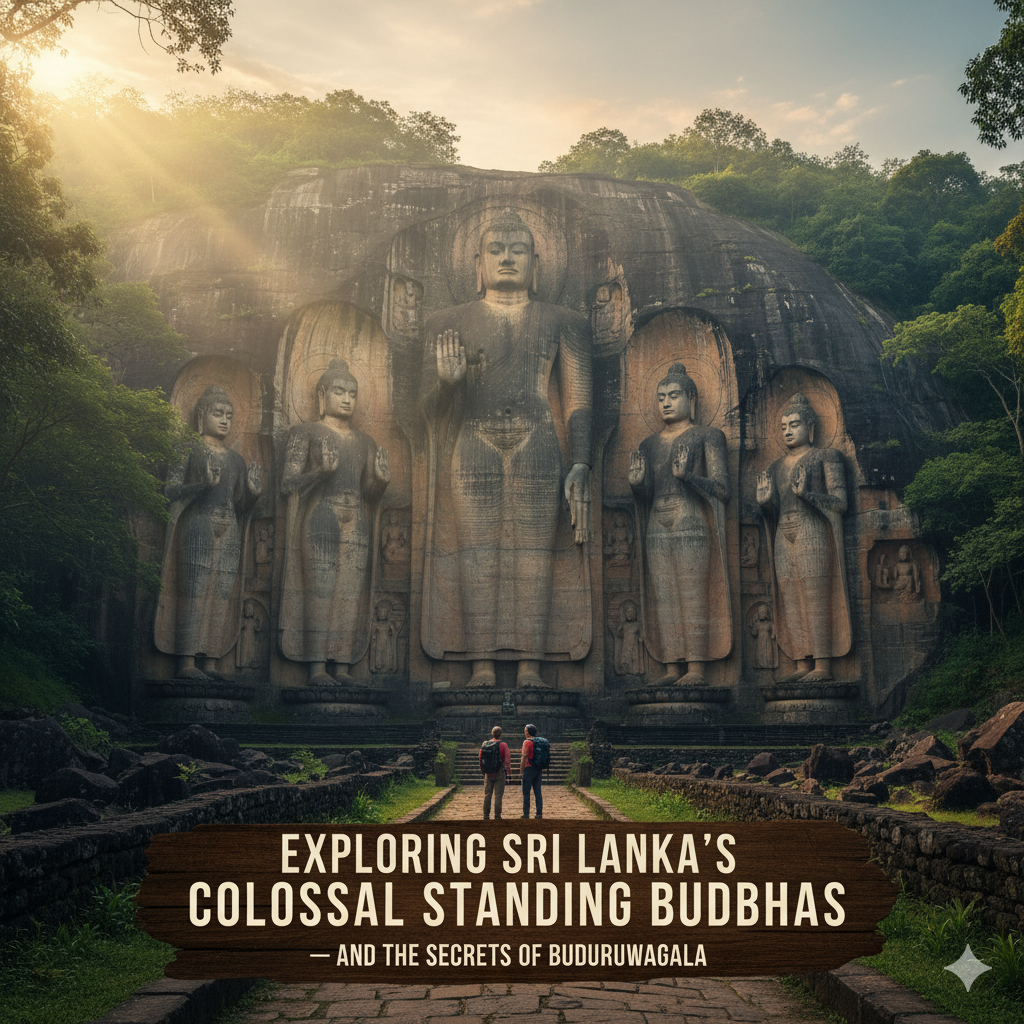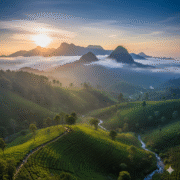
Exploring Sri Lanka’s Colossal Standing Buddhas – and the Secrets of Buduruwagala
- November 13, 2025
- eunoialankatours
- 6:02 pm
Sri Lanka’s central highlands and plains are home to huge stone statues that show the island’s lengthy Buddhist history. Five huge standing Buddha sculptures are quite well-known among them: Buduruwagala (Uva Province), Avukana (North Central Province), Sasseruwa (North Central Province), Dowa (Central Highlands), and Maligawila (Uva Province). They were all carved in distinct styles hundreds of years ago, which makes them a very interesting study of regional art.
Eunoia Lanka, a local tour company, loves taking visitors beyond the apparent to see these monuments in their cultural context. “Wonder of Diversification and Feel Like a Local” isn’t just a tagline; it’s our guarantee.
The Buduruwagala Rock Temple – Sri Lanka’s Tallest Buddha
Setting & History
Buduruwagala (“rock of the Buddha images”) is hidden in a teak forest about 4 km southeast of Wellawaya in Uva Province. A dirt track skirts wetland full of egrets and herons before reaching the site. The sculptures were carved around the 9th–10th century when the Mahāyāna school briefly flourished in Sri Lanka. There is little historical record – the temple may have been a hermitage – but legend says the seven figures represent a scene from Mahāyāna cosmology.
The Colossal Buddha
At the centre of the cliff is a 51-foot (16 m) standing Buddha – the tallest on the island. Unlike the free-standing statues at Avukana and Maligawila, Buduruwagala’s Buddha is carved in high relief directly into the rock. He wears a stuccoed robe that still bears traces of orange paint. The right hand is raised in abhaya-mudrā, a gesture of blessing and reassurance.
Other Figures at Buduruwagala
Three sculpted figures stand on either side of the central Buddha. They are carved slightly smaller (10–15 m) and depict Mahāyāna bodhisattvas and deities:
- Right group: The white-painted figure with a crown is Avalokiteśvara (Natha), the bodhisattva of compassion. His consort Tārā stands to his left; local belief says she wards off disasters. On Avalokiteśvara’s right is Prince Sudhāna, representing the earnest seeker.
- Left group: The main character, who is wearing an elaborate crown, is Maitreya, the future Buddha. Vajrapāṇi stands to his left with a vajra (thunderbolt) symbol. The image on the far left has missing parts, and experts think it could be Sahampathi Brahmā or Vishnu.
Unique Details:
- Each figure extends their right hand and bends two fingers down, which is a unique way to call someone.
- There are still signs of plaster and paint on these carvings, which means they were once very colourful.
- A hole in the rock nearby always leaks an oil that smells like mustard, which adds to the site’s mystery.
What Makes Buduruwagala Unique?
- Scale and Context: The main Buddha statue at Buduruwagala is taller than the free-standing Avukana and Maligawila sculptures. But since it is cut into living rock, it feels very much like being in the forest. People who visit often say that the gigantic figure looks like it emerged from the rock itself.
- Mahayāna Symbolism: Avalokiteśvara, Tārā, Maitreya, and Vajrapāṇi are all signs that Mahāyāna Buddhism was strong here. Other Sri Lankan standing Buddhas, on the other hand, follow the more strict Theravāda style.
- Mystery of the Oil Lamp: There is a 4-foot flame-shaped hole next to the Buddha’s right foot that is always full of a liquid that smells like mustard oil. People in the area think it’s a miracle lamp, but experts haven’t been able to explain it yet.
How Buduruwagala Compares with Sri Lanka’s Other Colossal Standing Buddhas
| Statue | Province & Setting | Approx. Height | Material & Style | Period/Creator | Unique Features |
| Buduruwagala | Uva Province, Wellawaya | 16 m | High-relief carving in rock; central Buddha flanked by six Mahāyāna figures | 9th–10th century | Tallest standing Buddha in Sri Lanka; accompanied by Mahāyāna Bodhisattvas; traces of paint. |
| Avukana (Aukana) | North Central Province near Kala Wewa | 13 m | Nearly free-standing sandstone/granite carving; connected to rock by a thin strip | 5th or 8th century | Considered the finest example of Sinhalese stone sculpture; āsisa-mudrā (blessing gesture) with left hand clutching robe. |
| Sasseruwa (Ras Vehera) | North Central Province, Reswehera | ≈12 m | Carved in a shallow rock niche; much of back still attached | 3rd–4th century (older than Avukana) | Slightly shorter than Avukana; unfinished details (missing flame, incomplete ear); abhaya-mudrā. |
| Dowa Rock Temple | Badulla District, between Bandarawela and Ella | ≈11 m | High-relief rock carving; unfinished due to brittle rock | 1st century BCE – 10th century | Face finely carved but lower body incomplete; associated cave temple has Kandyan-era murals. |
| Maligawila | Uva Province, near Okkampitiya | 11.53 m | Free-standing limestone sculpture; moved from quarry to site | 7th century | Tallest ancient free-standing Buddha in Sri Lanka; restored in 1991. |
Experiencing Buduruwagala and the Standing Buddhas with Eunoia Lanka
At Eunoia Lanka we believe that discovering Sri Lanka’s heritage isn’t just about ticking off monuments; it’s about connecting with the environment and the communities around them.
- Travel Like a Local: A small dirt road leads to Buduruwagala. Our guides will get you a tuk tuk or a bike so you can see the wetlands and get a taste of daily life in the countryside. Along the journey, you might observe locals picking rice, kids riding their bikes to school, and fisherman throwing nets in the tank. It’s a whole different world from the bus tour.
- Talk to the Monks: The temple at Buduruwagala still houses a small community of monks. With Eunoia’s local connections, we arrange respectful encounters so you can learn about their meditative lifestyle and the legends associated with the statues.
- Explore Lesser-Known Sites: A lot of people that travel to Avukana miss Reswehera (Sasseruwa), which is close by. Standing in front of the incomplete Sasseruwa Buddha and then going to the Avukana, which is a few kilometres away and has a lot of details, really shows the difference between perfection and rough appeal. We stop at village houses along the way for tea and sweets. These are things that make our guests feel like they are part of the community.
- Combine Nature and Culture: In the southern highlands, our tours connect the Dowa monument to waterfalls, tea gardens, and the Ravana Ella cave system. At the Dowa cave temple, you may see artists painting classic Kandyan-style murals. Then you can trek to Ella Gap for amazing views.
- Learn the Stories: Knowing the symbolism of the mudrās (hand gestures) and the identities of the side statues brings the carvings to life. For example, Avukana’s right hand is raised in āsisa-mudrā, a blessing gesture rarely seen outside Sri Lanka. The Sasseruwa Buddha’s softer expression and abhayamudrā evoke a different spiritual mood.
Conclusion
Sri Lanka’s standing Buddha statues are not just relics; they are storytellers. Avukana shining with its refined craftsmanship; Sasseruwa fascinates with its unfinished yet serene presence; Dowa inspires with its hidden cave murals; Maligawila impresses as the tallest free-standing ancient Buddha. But Buduruwagala, with its towering rock-cut Buddha, Mahāyāna companions and mysterious oil lamp, offers perhaps the most immersive encounter.
Eunoia Lanka’s passion is to weave these wonders into journeys that celebrate diversity and make travellers feel at home. Whether you’re meditating beneath the Bodhi tree at Buduruwagala or sharing a cup of buffalo curd with farmers near Maligawila, we’ll ensure you experience the Wonder of Diversification and Feel Like a Local.


